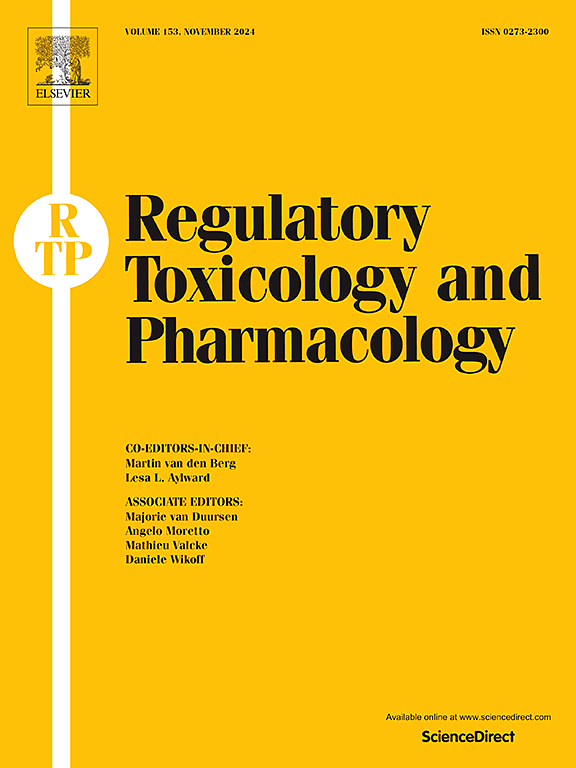在28天和90天的Sprague-Dawley大鼠饮食毒性研究中证实了味精的安全性。
IF 3.5
4区 医学
Q1 MEDICINE, LEGAL
引用次数: 0
摘要
谷氨酸钠是一种常用的增味剂,多年来一直是人类饮食的一部分,并经过了多个国际科学委员会和监管机构的安全性评估。有许多关于味精的研究,但其中许多研究对人类如何接触味精(即摄入食物)并不一致或具有代表性。EFSA(2017)和JECFA(2022)在评估中总结了两项符合glp的饮食啮齿动物研究,但从未发表。在第一项研究中,Sprague-Dawley大鼠组(10只/性别/组)被喂食含有0 ppm(基础日粮)或50,000 ppm味精的日粮29天。在第二项研究中,Sprague-Dawley大鼠各组(20只/性/组)分别饲喂味精含量为0(基础日粮)、0.5、1.5或5% (w/w)的日粮,为期92 ~ 96 d。两项研究中的动物均进行了临床检查、血液学和生物化学检查、全解剖和组织病理学检查。两项研究均未发现毒理学上的重大发现。在为期28天的研究中,5100 mg/kg体重/天(男性)和4800 mg/kg体重/天(女性)没有观察到不良反应。在为期90天的研究中,未观察到的不良反应水平(NOAEL)被确定为测试的最高剂量,为3,170毫克/公斤体重/天(男性)和3,620毫克/公斤体重/天(女性)或更高。本文章由计算机程序翻译,如有差异,请以英文原文为准。
The safety of monosodium glutamate demonstrated in 28-day and 90-day dietary toxicity studies with Sprague-Dawley rats
The commonly used flavor enhancer monosodium glutamate (MSG) has been part of the human diet for many years and has undergone safety evaluation by several international scientific committees and regulatory agencies. Numerous studies exist on MSG but many of these studies are not consistent or representative of how humans are exposed to MSG (i.e., ingestion of food). Two GLP-compliant dietary rodent studies were summarized in evaluations performed by EFSA (2017) and JECFA (2022) but were never published. In the first study, groups of Sprague-Dawley rats (10 rats/sex/group) were fed diets containing 0 ppm (basal diet) or 50,000 ppm MSG for 29 days. In the second study, groups of Sprague-Dawley rats (20 rats/sex/group) were fed diets containing 0 (basal diet), 0.5, 1.5, or 5 % (w/w) MSG for 92–96 days. Animals in both studies underwent clinical examinations, hematology and biochemistry tests, full necropsies, and histopathological examination. No toxicologically significant findings were reported in either study. In the 28-day study, there were no adverse effects observed at 5100 mg/kg bw/day (males) and 4800 mg/kg bw/day (females). In the 90-day study, a no-observed-adverse-effect level (NOAEL) was identified as the highest dose tested of 3170 mg/kg bw/day (males) and 3620 mg/kg bw/day (females) or more.
求助全文
通过发布文献求助,成功后即可免费获取论文全文。
去求助
来源期刊
CiteScore
6.70
自引率
8.80%
发文量
147
审稿时长
58 days
期刊介绍:
Regulatory Toxicology and Pharmacology publishes peer reviewed articles that involve the generation, evaluation, and interpretation of experimental animal and human data that are of direct importance and relevance for regulatory authorities with respect to toxicological and pharmacological regulations in society. All peer-reviewed articles that are published should be devoted to improve the protection of human health and environment. Reviews and discussions are welcomed that address legal and/or regulatory decisions with respect to risk assessment and management of toxicological and pharmacological compounds on a scientific basis. It addresses an international readership of scientists, risk assessors and managers, and other professionals active in the field of human and environmental health.
Types of peer-reviewed articles published:
-Original research articles of relevance for regulatory aspects covering aspects including, but not limited to:
1.Factors influencing human sensitivity
2.Exposure science related to risk assessment
3.Alternative toxicological test methods
4.Frameworks for evaluation and integration of data in regulatory evaluations
5.Harmonization across regulatory agencies
6.Read-across methods and evaluations
-Contemporary Reviews on policy related Research issues
-Letters to the Editor
-Guest Editorials (by Invitation)

 求助内容:
求助内容: 应助结果提醒方式:
应助结果提醒方式:


